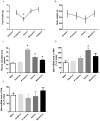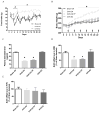Central expression and anorectic effect of brain-derived neurotrophic factor are regulated by circulating estradiol levels
- PMID: 23376487
- PMCID: PMC3624754
- DOI: 10.1016/j.yhbeh.2013.01.009
Central expression and anorectic effect of brain-derived neurotrophic factor are regulated by circulating estradiol levels
Abstract
Estrogens potently suppress food intake. Compelling evidence suggests that estradiol, the primary form of estrogens, reduces food intake by facilitating other anorectic signals. Brain-derived neurotrophic factor (BDNF), like estradiol, appears to suppress food intake by affecting meal size. We hypothesized that estradiol modulates Bdnf expression and the anorectic effect of BDNF. The first goal was to determine whether Bdnf expression was regulated by endogenous estradiol of cycling rats and by cyclic estradiol treatment using ovariectomized rats. Bdnf expression within the ventromedial nucleus of hypothalamus (VMH) was temporally elevated at estrus following the estradiol peak, which coincided with the decline in feeding at this phase of the ovarian cycle. Additionally, food intake and body weight were increased following ovariectomy with a parallel decrease in Bdnf expression in the VMH. All of these alterations were reversed by cyclic estradiol treatment, suggesting that Bdnf expression within the VMH was regulated in an estradiol-dependent manner. The second goal was to determine whether estradiol modulates the anorectic effect of BDNF. Sham-operated estrous rats and ovariectomized rats cyclically treated with estradiol responded to a lower dose of central administration of BDNF to decrease food intake than male rats and oil-treated ovariectomized rats, implying that endogenous estradiol or cyclic estradiol replacement increased the sensitivity to anorectic effect of BDNF. These data indicate that Bdnf expression within the VMH and the anorectic effect of BDNF varied depending on plasma estradiol levels, suggesting that estradiol may regulate BDNF signaling to regulate feeding.
Copyright © 2013 Elsevier Inc. All rights reserved.
Figures



Similar articles
-
Effects of energy status and diet on Bdnf expression in the ventromedial hypothalamus of male and female rats.Physiol Behav. 2014 May 10;130:99-107. doi: 10.1016/j.physbeh.2014.03.028. Epub 2014 Apr 4. Physiol Behav. 2014. PMID: 24709620 Free PMC article.
-
Brain-derived neurotrophic factor in the ventromedial nucleus of the hypothalamus reduces energy intake.Am J Physiol Regul Integr Comp Physiol. 2007 Sep;293(3):R1037-45. doi: 10.1152/ajpregu.00125.2007. Epub 2007 Jun 6. Am J Physiol Regul Integr Comp Physiol. 2007. PMID: 17553842
-
Brain-derived neurotrophic factor (BDNF) in the hypothalamic ventromedial nucleus increases energy expenditure.Brain Res. 2010 Jun 8;1336:66-77. doi: 10.1016/j.brainres.2010.04.013. Epub 2010 Apr 14. Brain Res. 2010. PMID: 20398635 Free PMC article.
-
The rise, fall, and resurrection of the ventromedial hypothalamus in the regulation of feeding behavior and body weight.Physiol Behav. 2006 Feb 28;87(2):221-44. doi: 10.1016/j.physbeh.2005.10.007. Epub 2006 Jan 18. Physiol Behav. 2006. PMID: 16412483 Review.
-
The ovarian hormone estradiol plays a crucial role in the control of food intake in females.Physiol Behav. 2011 Sep 26;104(4):517-24. doi: 10.1016/j.physbeh.2011.04.014. Epub 2011 Apr 20. Physiol Behav. 2011. PMID: 21530561 Free PMC article. Review.
Cited by
-
An ERβ agonist induces browning of subcutaneous abdominal fat pad in obese female mice.Sci Rep. 2016 Dec 6;6:38579. doi: 10.1038/srep38579. Sci Rep. 2016. PMID: 27922125 Free PMC article.
-
Sex Steroids and Brain-Derived Neurotrophic Factor Interactions in the Nervous System: A Comprehensive Review of Scientific Data.Int J Mol Sci. 2025 Mar 12;26(6):2532. doi: 10.3390/ijms26062532. Int J Mol Sci. 2025. PMID: 40141172 Free PMC article. Review.
-
BARHL1 Is Downregulated in Alzheimer's Disease and May Regulate Cognitive Functions through ESR1 and Multiple Pathways.Genes (Basel). 2017 Sep 28;8(10):245. doi: 10.3390/genes8100245. Genes (Basel). 2017. PMID: 28956815 Free PMC article.
-
Disruption of brain-derived neurotrophic factor production from individual promoters generates distinct body composition phenotypes in mice.Am J Physiol Endocrinol Metab. 2018 Dec 1;315(6):E1168-E1184. doi: 10.1152/ajpendo.00205.2018. Epub 2018 Sep 25. Am J Physiol Endocrinol Metab. 2018. PMID: 30253111 Free PMC article.
-
Sex and estradiol effects in the rodent dorsal striatum.Eur J Neurosci. 2024 Dec;60(12):6962-6986. doi: 10.1111/ejn.16607. Epub 2024 Nov 21. Eur J Neurosci. 2024. PMID: 39573926 Free PMC article. Review.
References
-
- Anand BK, Brobeck JR. Localization of a “feeding center” in the hypothalamus of the rat. Proc Soc Exp Biol Med. 1951;77(2):323–325. - PubMed
-
- Asarian L, Geary N. Cyclic estradiol treatment normalizes body weight and restores physiological patterns of spontaneous feeding and sexual receptivity in ovariectomized rats. Horm Behav. 2002;42(4):461–471. - PubMed
-
- Barr SI, Janelle KC, Prior JC. Energy intakes are higher during the luteal phase of ovulatory menstrual cycles. Am J Clin Nutr. 1995;61(1):39–43. - PubMed
-
- Becker JB, Arnold AP, Berkley KJ, Blaustein JD, Eckel LA, Hampson E, Herman JPS, Marts, Sadee W, Steiner M, Taylor J, Young E. Strategies and methods for research on sex differences in brain and behavior. Endocrinology. 2005;146(4):1650–1673. - PubMed
Publication types
MeSH terms
Substances
Grants and funding
LinkOut - more resources
Full Text Sources
Other Literature Sources

